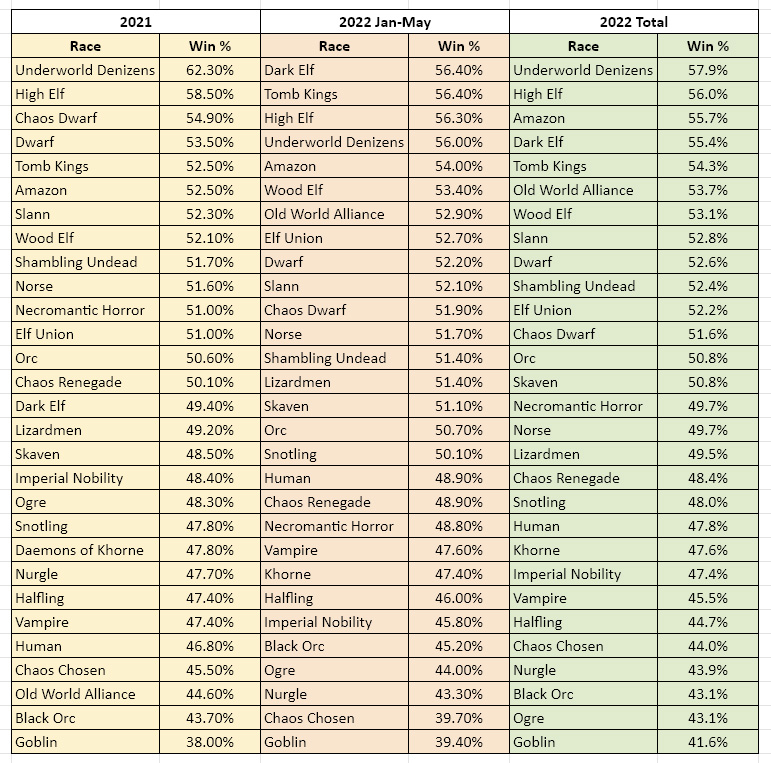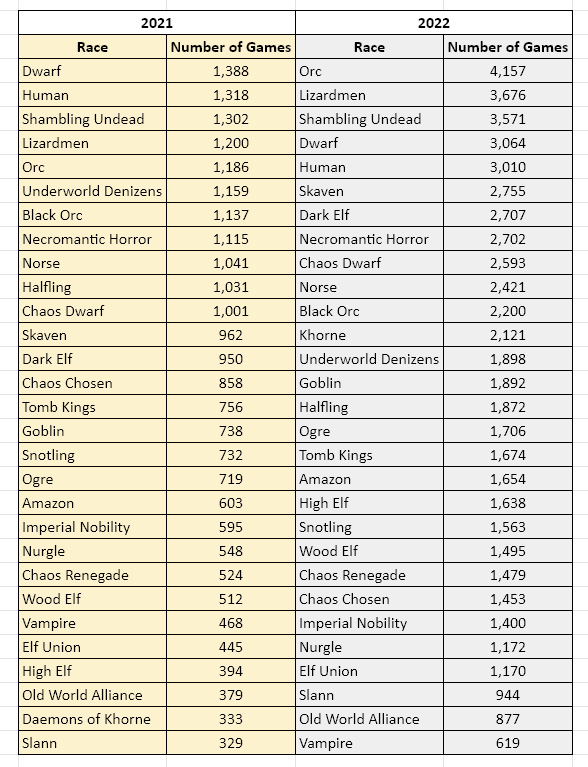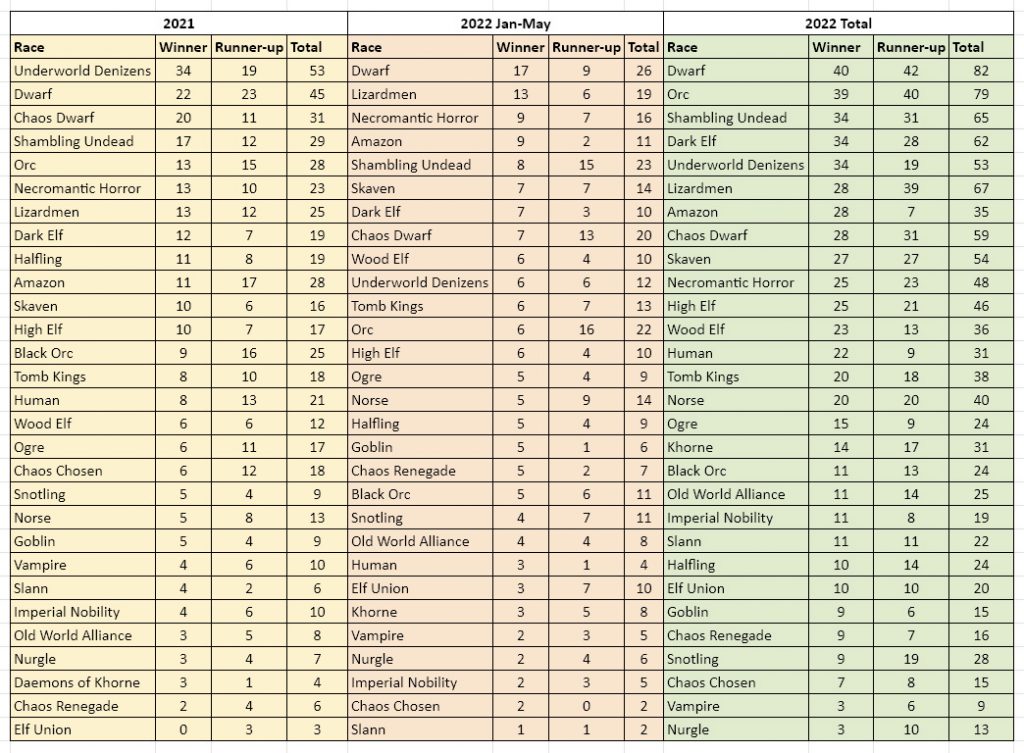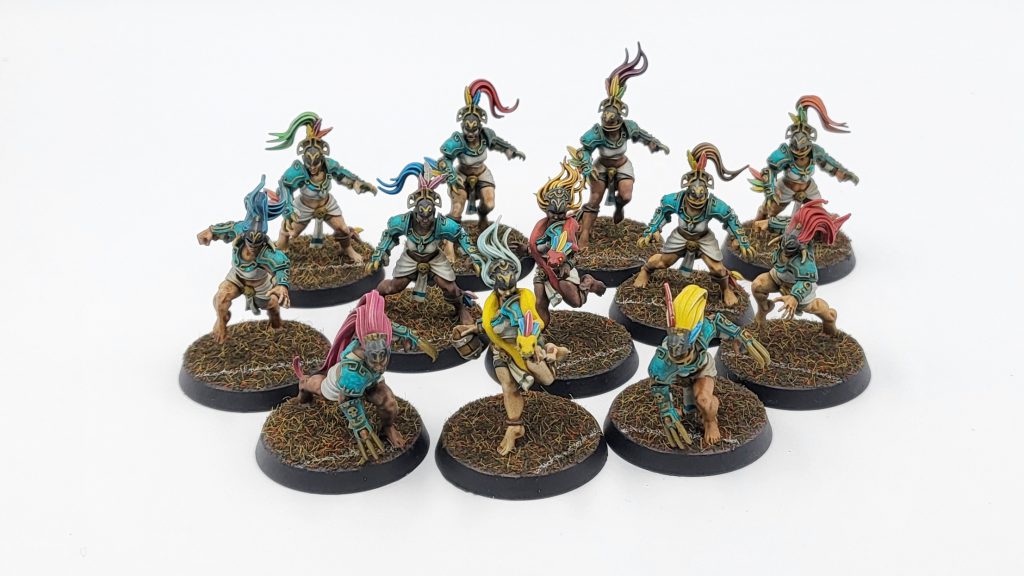Earlier last year we did our first Goonhammer look at the Blood Bowl Tournament meta. For the first time in a long time, Blood Bowl has become a game much like other GW games, where we see changes, updates, and additions on a semi-regular basis, and that means our meta has more potential and likelihood to shift than probably ever before. In this article we’re going to take a look over the latter half of 2022 to see the impact of those changes and other developments in the world of Blood Bowl Tournament play, and where it leaves the Blood Bowl meta as we kick-off 2023.
As always, we are indebted to the work of Mike Davies who has gathered and presented much of the NAF’s data for easy consumption.
For consideration throughout this article, here is a summary of some of the bigger changes to the world of Blood Bowl influencing the period we are covering
- Norse team updated shortly before this period
- Amazon team updated about half-way through it
- BB FAQ updated in November
One thing to note before we go anywhere else, number of games played was through the roof in 2022 compared to 2021. Our data includes more than twice as many Tournaments as last year. Blood Bowl (and tabletop gaming in general) is back in a big way after the tough Lockdown period. That’s a nice thing for this kind of analysis because it means our sample size is a bit more robust, but it’s also great to be covering a game in such rude competitive health.
Finally, a note on Tiering and Rules Packs. As we have noted many times, Tournaments generally do not follow the Tiering allocated in the BB20 rules. Unfortunately there is no way of knowing what exact tier a team was classed in at any given tournament, nor what benefit that tournament’s rules pack gave teams of any given tier. Equally we don’t always know if a tournament allowed or restricted Star Players.
Win Rates

Last time round we compared the BB16 era with 2021 and the first half of 2022. This time we’ll push forward to compare 2021 and both periods of 2022.
On a high level, our outliers from 2021 have noticeably come in. We’ve gone from having a 62.3% win rate best team and 38% win rate worst team to 57.9% and 41.6% respectively. So that seems to be a good sign of Meta health.
Interestingly, and perhaps surprisingly, Underworld once again topped the chart. Their win rate increased in the back half of the year to very high levels. I can’t think of any particular reason that should be the case, so it will be one to monitor in future.
High Elves retained their place in the highest echelons of the meta, and so did Amazons (who we’ll talk about in more detail later), Dark Elves, and Tomb Kings. At this point, we can stop looking at High Elves and Tomb Kings as outliers. Probably the main point of discussion now is if these teams should still be considered (as they traditionally are) as Tier 2 teams.
The surprise team is certainly Old World Alliance. They have a lower sample size than almost every team on this list, but more than enough games to be considered merely an oddity. And this is a team that has commonly been considered pretty terrible, and universally agreed to be worse than the BB16 version, so their numbers certainly bear further analysis. Initial findings based on what we saw in the Eurobowl data was that this was a team that was used as a vehicle for Griff Oberwald or other strong Stars.
Other notable teams to pick out include Lizardmen, who at 49.5% have continued sub-50% win rates in the BB20 world. Lizards have become the second-most played team, behind Orcs, which may be a factor here. Skaven and Necromantic fit into a similar category here.
Our first full year of the revamped Khorne team has seen them in the lower end of the list, much as their original iteration was. As a fun take on the Chaos concept who certainly can be good, I think GW deserve credit for their addition.
Black Orcs certainly seem to have found their level, and it is not good. Early 2022 win rates had improved, but they have finished almost exactly where they did in 2021 with 43.1%, the third-worst in the game. This is a team that still sometimes finds itself in higher tiers in rules packs, so this might be something for TO’s to take a look at and give Blorcs some help.
Popularity

We touched on Popularity last time round in terms of how it can affect win rates of the popular teams, but I think it’s worth discussing in its own right. This is the meta after all in the very real sense of what you are likely to be playing against at any given tournament.
Five teams have held the most-played spots (at various positions) in both of the last two years: Dwarves, Humans, Lizards, Orcs, Undead. All of these teams had over 3,000 games each this year, and together featured in over a quarter of all Blood Bowl played.
If we contrast that with the BB16 world, that top five was Orcs, Undead, Wood Elves, Dark Elves, and Humans. Wood Elves have precipitously declined in popularity in BB20, featuring as the 8th and 9th least popular team in 2021 and 2022. Their Dark Elf cousins were in the middle of the pack in 2021, but have come back strongly in 2022 as the 7th most popular team.
One of the other big fallers in popularity are Chaos Chosen. They seem to be suffering in multiple ways in this edition, with a tanking win rate and historically low popularity. Undoubtedly, the release of Khorne will have split the blood-hungry Chaos community, but the Blood Bowl world is rich in mid-tier bashers now, and the Claw/Mighty Blow changes have certainly taken away some of their unique appeal and fear factor.
The fact that our ninth- and seventeenth-most popular teams, Chaos Dwarves and Tomb Kings, still don’t have an official set of miniatures in the modern Blood Bowl era, is perhaps something that GW might like to work on.
Tournament Winners

So enough about win rates and fan favourites, what about the teams that took home the silverware? The champion of champions, by a beard hair’s-breadth, is Dwarves, who cement their mid-season position to take most Tournament Winners and most Runner-Up spots. Very close behind are Orcs, who were showing strong as Runners-up mid-season but have kicked on with a huge number of tourney wins. And rounding out our top 3 are Undead, who had a similar story to the Orcs.
These three ranked 2nd, 4th, and 5th overall in 2021, so there has not been a huge shift, but the main losers have been Underworld, who have fallen back into a still-creditable 5th spot. The other faller are Chaos Dwarves, who in 8th place remain a very popular and successful team, but have a more even proportion of Runner-up to Winner spots than they did in 2021.
Behind our top 3 we have Lizardmen, who despite their poor overall Win Rate remain one of the best options for players hunting trophies, with the third highest Winner + Runner-Up total. Our most skewed competitor is Amazons, in 7th place, who have a remarkable 28-7 ratio of Wins to Runner-Up spots.
Dropping off the face of the Earth are Halflings, who were our 9th placed team in 2021. Undoubtedly this fall is due to various star-based builds getting slapped down by TO’s and FAQ’s. We’ll see if the recent arrival of some low-cost Halfling Stars causes any change in 2023.
Amazons And Norse

It seems appropriate to look more closely at our refreshed teams. The Amazon numbers are not entirely easy to analyse as they were released in September, half-way through our data set, and we know for a fact that some tournaments that had been organised in advance of the roster updates (such as Eurobowl) continued to use the old roster. We settled for cutting the data to reflect only games played in November and December, and removed the Eurobowl results.
On that basis, Amazons showed a 56.7% win rate from 386 games. Not the largest sample size, but a very strong showing. They showed good matchups against a number of Meta threats such as High Elves, Tomb Kings, and Undead, but the old flaws in the roster remained, with the Dwarf matchup falling to 38%. They also had a very poor record against Underworld, with a 36.7% win rate. It’s very early days for what feels like a new team, and no doubt many players are still experimenting with builds, but I would suggest TO’s continue to keep them in Tier 1 of Rules Packs.
The revised Norse roster came out before our most recent data set and I think was pretty much universally adopted immediately. Their Win rate in the second half of the year was 48.8%. That is down on the 51.7% they showed in the first part of the year.
Norse had some bad matchups against Undead (41%) and Tomb Kings (36.6%), and also struggled badly against Dark Elves, High Elves and Elven Union. Their only real highlight is good matchups with Dwarves (54%) and an excellent matchup with Chaos Dwarves (58.6%). Again, no doubt many coaches have been experimenting with Beer Boars, the revised positionals, and the new stars, but it certainly seems Norse have not improved in this meta
Tournament Rule Packs And The Games Workshop Influence

We’ve touched on this a couple of times in this feature, but we cannot underestimate the impact that Tournament Organisers and their Rules Packs play in defining this meta. The shift to penalise Star-based builds has become a universal, whether it be through outright banning, which seems less common now, or through creating rules packs in which heavy cost in gold or skills are paid to gain Stars. Tiering, again, because of the nature of Blood Bowl tournament skill and cash allocation, remains a huge determinant in some teams’ viability, and in holding others back.
Games Workshop have now thrown their own oar into the world of tournament organisation and regulation with their Matched Play Guide release. I was guilty of being a little dismissive of this when we first saw it, not in the sense of thinking it was bad, but just in the sense that it felt to me like a beginner’s guide to NAF-style play (and it has some heavy padding). But GW have made this book more relevant to Tourney veterans with the introduction of the Mega-Stars concept, which creates a new mechanic for managing some of the scene’s biggest boogeymen. The actual list of Mega-Stars has been distributed through the FAQ rather than this book, which opens the door to GW making further changes and balancing Stars through this mechanism in future.
Furthermore there have been some whispers about the possibility that GW might be developing their own official Tournament series. It will be very interesting to see if GW continue to make moves into the world of competitive Blood Bowl, whether TO’s absorb some of these official matched play rules, and what impact all of this has on the NAF world and the nature of competitive play through 2023.
Have any questions or feedback? Drop us a note in the comments below or email us at contact@goonhammer.com.


